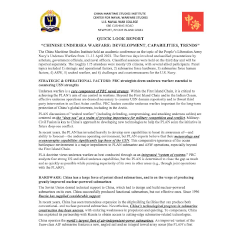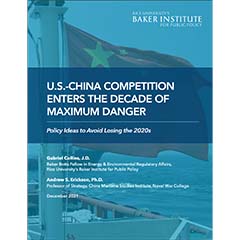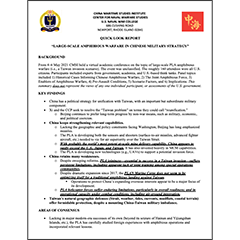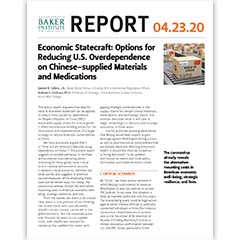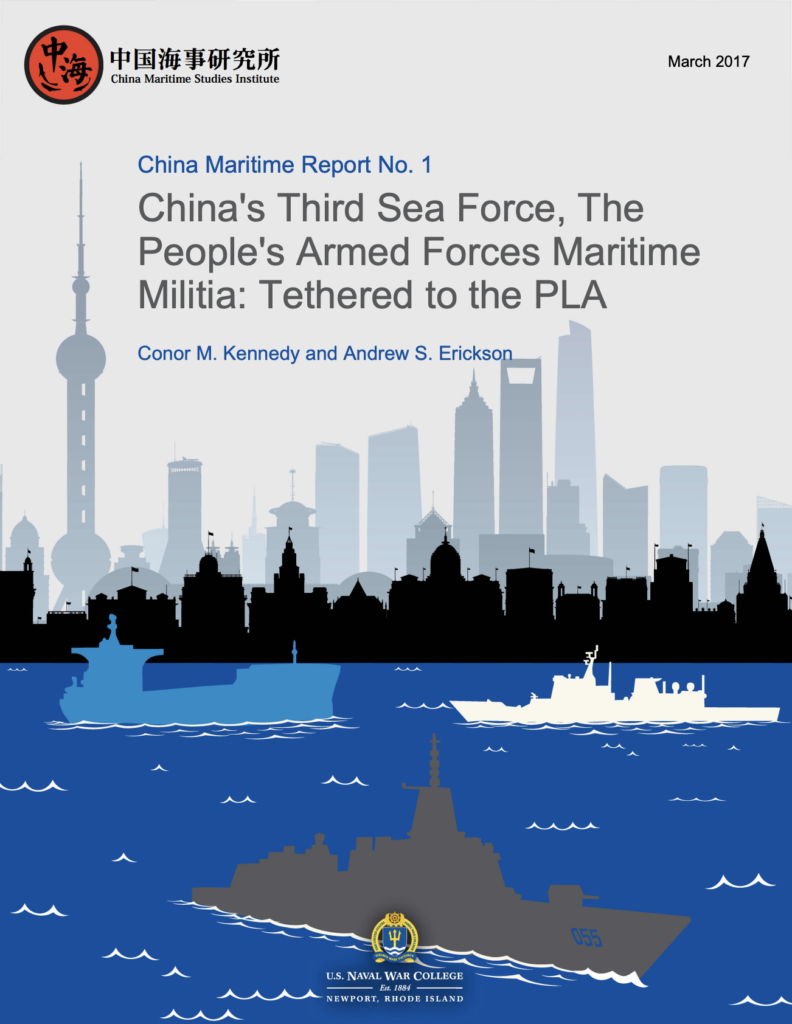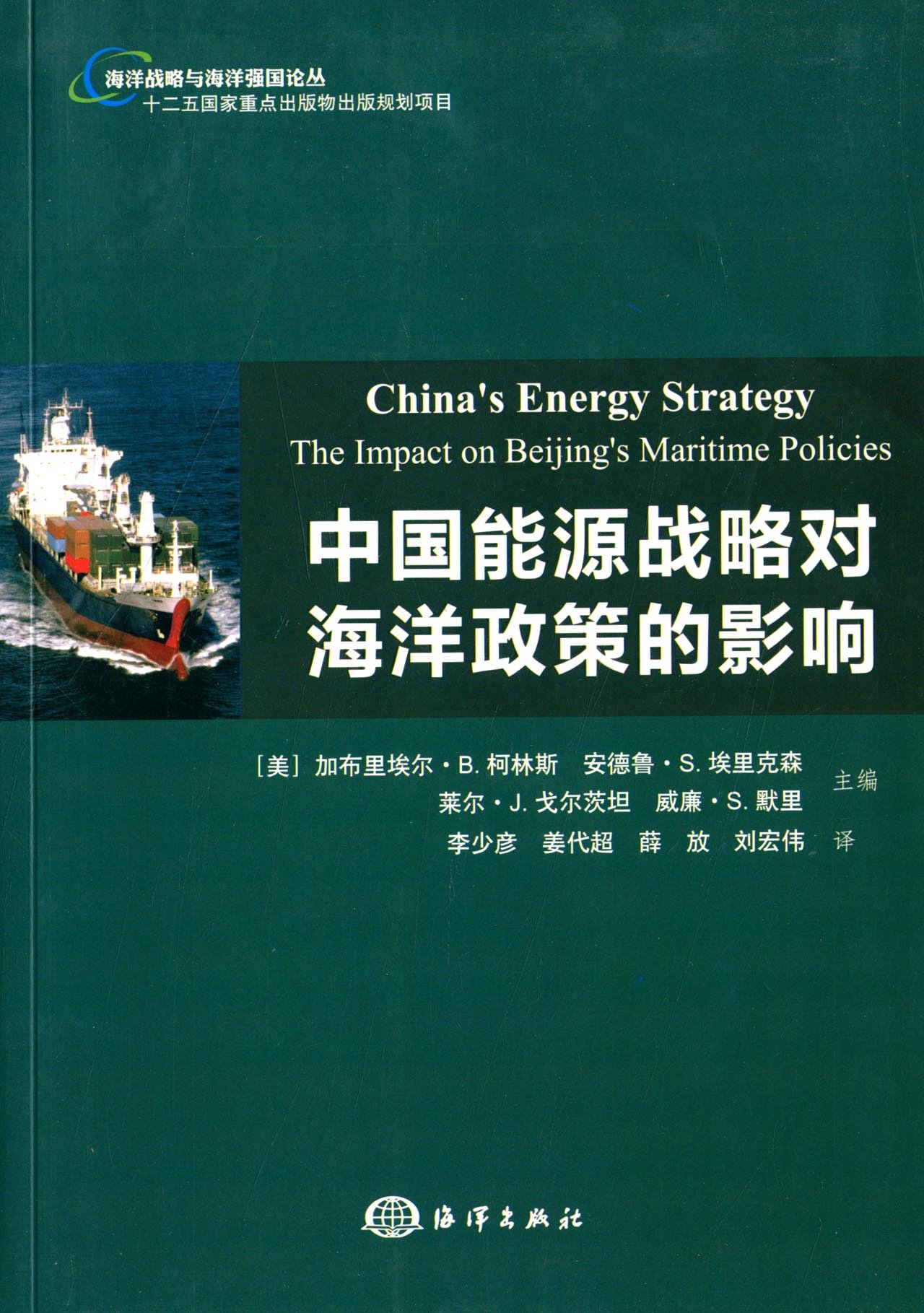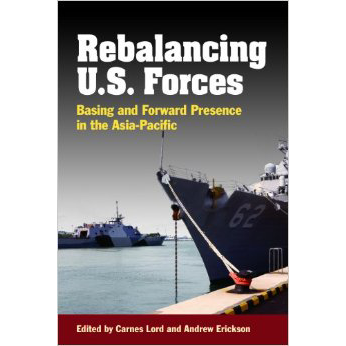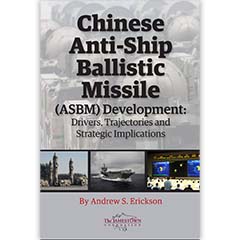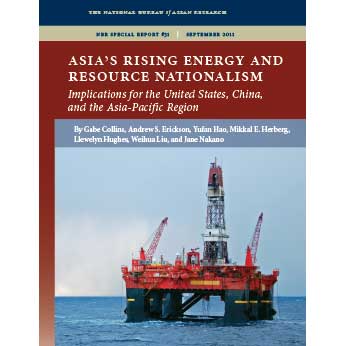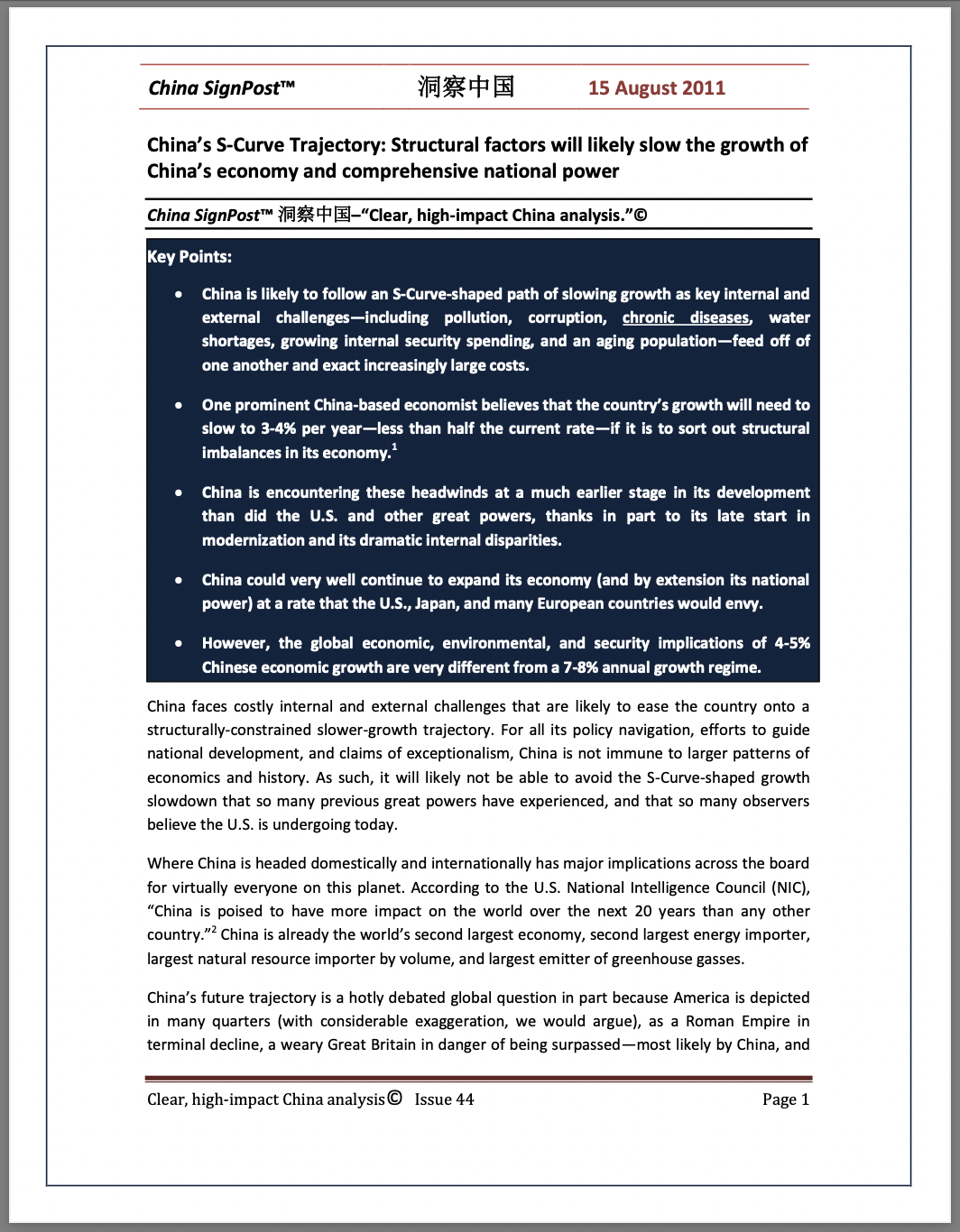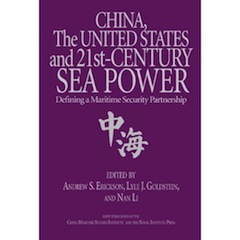New—285th Iteration! Ron O’Rourke’s Latest CRS Report—“China Naval Modernization: Implications for U.S. Navy Capabilities”
Ronald O’Rourke, China Naval Modernization: Implications for U.S. Navy Capabilities—Background and Issues for Congress, RL33153 (Washington, DC: Congressional Research Service, 24 April 2025).
Having trouble accessing the website above? Please download a cached copy here!
You can also click here to access the report via the public CRS website.
SUMMARY
China’s military modernization effort, including its naval modernization effort, is the top focus of U.S. defense planning and budgeting. China’s naval modernization effort has been underway for about 30 years, since the early to mid-1990s, and has transformed China’s navy into a much more modern and capable force. China’s navy is a formidable military force within China’s near-seas region, and it is conducting a growing number of operations in the broader waters of the Western Pacific, the Indian Ocean, and waters around Europe.
China’s navy is, by far, the largest of any country in East Asia, and sometime between 2015 and 2020 it surpassed the U.S. Navy in numbers of battle force ships, meaning the types of ships that count toward the quoted size of the U.S. Navy. DOD states that China’s navy “is the largest navy in the world with a battle force of over 370 platforms [i.e., ships], including major surface combatants, submarines, ocean-going amphibious ships, mine warfare ships, aircraft carriers, and fleet auxiliaries. Notably, this figure does not include approximately 60 HOUBEI-class patrol combatants that carry anti-ship cruise missiles (ASCM). The… overall battle force [of China’s navy] is expected to grow to 395 ships by 2025 and 435 ships by 2030.” The U.S. Navy, by comparison, included 296 battle force ships as of September 30, 2024, and the Navy’s FY2025 budget submission projects that the Navy will include 294 battle force ships by the end of FY2030. U.S. military officials and other observers are expressing concern or alarm regarding the pace of China’s naval shipbuilding effort, the capacity of China’s shipbuilding industry compared with the capacity of the U.S. shipbuilding industry, and trend lines regarding the relative sizes and capabilities of China’s navy and the U.S. Navy.
China’s naval modernization effort encompasses a wide array of ship, aircraft, weapon, and C4ISR (command and control, communications, computers, intelligence, surveillance, and reconnaissance) acquisition programs, as well as improvements in logistics, doctrine, personnel quality, education and training, and exercises. China’s navy currently has certain limitations and weaknesses, which it is working to overcome. China’s military modernization effort, including its naval modernization effort, is assessed as being aimed at developing capabilities for, among other things, addressing the situation with Taiwan militarily, if need be; achieving a greater degree of control or domination over [the] near-seas region, particularly the South China Sea; defending China’s commercial sea lines of communication (SLOCs), particularly those linking China to the Persian Gulf; displacing U.S. influence in the Western Pacific; and asserting China’s status as the leading regional power and a major world power. Observers believe China wants its navy to be capable of acting as part of an anti-access/area-denial (A2/AD) force—a force that can deter U.S. intervention in a conflict in [the] near-seas region over Taiwan or some other issue, or failing that, delay the arrival or reduce the effectiveness of intervening U.S. forces.
The U.S. Navy has taken a number of actions to counter China’s naval modernization effort. Among other things, the U.S. Navy has shifted a greater percentage of its fleet to the Pacific; assigned its most-capable new ships and aircraft to the Pacific; maintained or increased general presence operations, training and developmental exercises, and engagement and cooperation with allied and other navies in the Indo-Pacific; increased the planned future size of the Navy; initiated, increased, or accelerated numerous programs for developing new military technologies and acquiring new ships, aircraft, unmanned vehicles, and weapons; and developed new operational concepts for countering PRC maritime A2/AD forces. The issue for Congress is whether to approve, reject, or modify the Trump Administration’s proposed U.S. Navy plans, budgets, and programs for responding to China’s naval modernization effort.
KEY CONTENT
p. 6
Numbers of Ships; Comparisons to U.S. Navy
Overview
DOD states
The PLAN is the largest navy in the world with a battle force of over 370 platforms [i.e., ships], including major surface combatants, submarines, ocean-going amphibious ships, mine warfare ships, aircraft carriers, and fleet auxiliaries. Notably, this figure does not include approximately 60 HOUBEI class patrol combatants that carry anti-ship cruise missiles (ASCM). The PLAN’s overall battle force is expected to grow to 395 ships by 2025 and 435 ships by 2030. Much of this growth will be in major surface combatants.27
DIA states that “the PLAN is rapidly retiring older, single-mission warships in favor of larger, multimission ships equipped with advanced antiship, antiair, and antisubmarine weapons and sensors and C2 [command and control] facilities.”28
Another set of observers states
China’s rapid military buildup has left the People’s Liberation Army Navy (PLAN) poised to overtake the U.S. Navy in several measures of maritime might more quickly than sometimes assumed. If China continues to expand its fleet at the current pace and the United States does not revitalize its shipbuilding industry, China will grow increasingly likely to emerge victorious from interstate war, especially a prolonged great power war….
***
25 DOD states that
The CCG’s continued expansion and modernization makes it the largest maritime law enforcement fleet in the world. Newer CCG vessels are larger and more capable, enabling them to operate farther off shore and remain on station longer. The CCG has over 150 regional and oceangoing patrol vessels (more than 1,000 tons). These larger vessels include over 20 corvettes transferred from the PLAN, which were modified for CCG operations. The newer, larger CCG vessels are equipped with helicopter facilities, high-capacity water cannons, multiple interceptor boats and guns ranging from 30 mm to 76 mm. Revised estimates indicate the CCG operates more than 50 regional patrol combatants (more than 500 tons), which can be used for limited offshore operations, and an additional 300 coastal patrol craft (100 tons to 499 tons). In 2023 and early 2024, the CCG launched seven offshore patrol ships as well as two additional patrol ships based on a large salvage ship design. Several more offshore patrol ships are likely under construction.
(2024 DOD CMSD, pp. 76-77. See also 2019 DIA CMP, p. 78.)
26 2024 DOD CMSD, pp. 76-78, and CRS Report R42784, U.S.-China Strategic Competition in South and East China Seas: Background and Issues for Congress, by Ronald O’Rourke.
27 2024 DOD CMSD, p. 51. See also 2019 DIA CMP, p. 63.
28 2019 DIA CMP, p. 69.
p. 7
China now possesses the world’s largest maritime fighting force, operating 234 warships [excluding auxiliary and support ships] to the U.S. Navy’s 219 [warships excluding auxiliary and support ships].29
Ultimate Size and Composition of China’s Navy Not Publicly Known
The planned ultimate size and composition of China’s navy is not publicly known. The U.S. Navy makes public its force-level goal and regularly releases a 30-year shipbuilding plan that shows planned procurements of new ships, planned retirements of existing ships, and resulting projected force levels, as well as a five-year shipbuilding plan that shows, in greater detail, the first five years of the 30-year shipbuilding plan.30 In contrast, China does not release a navy force-level goal or detailed information about planned ship procurement rates, planned total ship procurement quantities, planned ship retirements, or resulting projected force levels. The ultimate size and composition of China’s navy might be an unsettled and evolving issue among China’s military and political leaders. One observer states that “it seems the majority of past foreign projections of Chinese military and Chinese navy procurement scale and speed have been underestimates…. All military forces have a desired force requirement and a desired ‘critical mass’ to aspire toward. Whether the Chinese navy is close to its desired force or not, is of no small consequence.”31
Number of Ships Is a One-Dimensional Measure, but Trends in Numbers Can Be of Value Analytically
Relative U.S. and PLA naval capabilities are sometimes assessed by showing comparative numbers of U.S. and PLA ships (or comparative aggregate fleet displacements [i.e, tonnages]). Although the total number of ships in a navy (or a navy’s aggregate displacement) is relatively easy to calculate, it is a one-dimensional measure that leaves out numerous other factors that bear on a navy’s capabilities and how those capabilities compare to its assigned missions. As a result, as discussed in further detail in Appendix A, comparisons of the total numbers of ships in China’s navy and the U.S. Navy (or aggregate displacements) are highly problematic as a means of assessing relative U.S. and PLA naval capabilities and how those capabilities compare to the missions assigned to the two navies. At the same time, however, an examination of trends over time in these relative numbers of ships (or aggregate displacements) can shed some light on how the relative balance of U.S. and PLA naval capabilities might be changing over time.
Tables Showing Numbers of PLA Navy and U.S. Navy Ships
Table Showing Figures from Annual DOD Reports
Table 1 shows numbers of certain types of PLA Navy ships—those that might be thought of as the principal combat ships (PCSs)32 of China’s navy—from 2004 to the present, along with the number of China Coast Guard ships from 2016 to the present, as presented in DOD’s annual reports on military and security developments involving China. (The DOD report for a given year
***
29 Alexander Palmer, Henry H. Carroll, and Nicholas Velazquez, “Unpacking China’s Naval Buildup,” Center for Strategic and International Studies (CSIS), June 5, 2024.
30 For more information on the U.S. Navy’s force-level goal, 30-year shipbuilding plan, and five-year shipbuilding plan, see CRS Report RL32665, Navy Force Structure and Shipbuilding Plans: Background and Issues for Congress, by Ronald O’Rourke.
31 Rick Joe, “Hints of Chinese Naval Procurement Plans in the 2020s,” Diplomat, December 25, 2020.
32 The term principal combat ships (PCSs) is a term used in this CRS report.
p. 8
presents data for PLA forces for the previous year.)33 As can be seen in Table 1, most PLA Navy ships shown in the table have increased numerically since 2004.
***
33 Thus, the 2023 edition of the DOD report covers presents data for 2022, and so on for prior-year editions of the report.
p. 9
China for the year prior to the report’s cover date. For example, the 2005 edition of the DOD report shows data for 2004.
Key to abbreviations: n/a = data not available in annual DOD report. SSB = ballistic missile submarines. SSN = nuclear-powered attack submarines. SS = diesel attack submarines. CV = aircraft carriers. CG = cruisers. DD = destroyers. FF = frigates. FFL = corvettes (i.e., light frigates). PC = missile-armed patrol craft. LST = amphibious tank landing ship. LPD = amphibious transport dock ship. LSM = amphibious medium landing ship. (Starting with the 2021 edition, the annual DOD report shows a combined figure for LST/LPD and LSM.) Column for Total PLAN ship types shown to right, which shows what might be thought of as the principal combat ships of China’s navy, does not include other PLAN ship types not shown to right, such as auxiliary and support ships. CCG = China Coast Guard ships. U.S. total = Total U.S. Navy battle force ships, which includes auxiliary and support ships but excludes patrol craft (although the U.S. Navy has very few patrol craft). U.S. vs. PLAN ship types shown = total U.S. Navy battle force ships compared to the column for Total PLAN ship types shown to right.
As can be seen in Table 1, about 84% of the net increase in the total number of PLA ships since 2004 (a net increase of 97 ships out of the total net increase of 116 ships) resulted from increases in cruisers and destroyers (29 ships), corvettes (i.e., light frigates) (50 ships), and amphibious ships (18 ships). The corvettes alone account for about 43% of the total net increase.
Table 1 lumps together less capable older PLA ships with more capable modern PLA ships. In examining the numbers in the table, it can be helpful to keep in mind that for many of the types of PLA ships shown in the table, the percentage of the ships accounted for by more capable modern designs was growing over time, even if the total number of ships for those types was changing little.
For reference, Table 1 also shows the total number of U.S. Navy battle force ships (BFSs), meaning the types of ships that count toward the quoted size of the U.S. Navy, and compares it to the total number of the types of PLA ships that are shown in the table. The result is an apples-vs.-oranges comparison, because the PLA figures exclude auxiliary and support ships, while the U.S. Navy figure includes auxiliary and support ships but excludes patrol craft (although the U.S. Navy has very few patrol craft). Changes over time in this apples-vs.-oranges comparison, however, can be of value in understanding trends in the comparative sizes of the U.S. and PLA navies.
On the basis of the figures in Table 1, it might be said that in 2014, the total number of principal combat ships in China’s navy (a figure that excludes PLAN auxiliary and support ships) surpassed the total number of U.S. Navy battle force ships (a figure that includes U.S. Navy auxiliary and support ships). It is important, however, to keep in mind the differences in composition between the two navies. The U.S. Navy, for example, has many more aircraft carriers, nuclear-powered submarines, and cruisers and destroyers, while China’s navy has many more diesel attack submarines, frigates, and corvettes.34
Table Showing ONI Figures from February 2020
Table 2 shows comparative total numbers of PLA Navy and U.S. Navy battle force ships (BFSs), as well as specific figures for certain types of ships that contribute toward China’s total number of battle force ships from 2000 to 2030, with the figures for 2025 and 2030 being projections. The figures for China’s ships are taken from an ONI information paper of February 2020. (As noted earlier, battle force ships are the types of ships that count toward the quoted size of the U.S. Navy. The ONI information paper applied the same counting rules to the PLA Navy.) For China, the total number of battle force ships shown excludes the missile-armed patrol craft (PCs) shown in
***
34 For further discussion on this point, see Alexander Palmer, Henry H. Carroll, and Nicholas Velazquez, “Unpacking China’s Naval Buildup,” Center for Strategic and International Studies (CSIS), June 5, 2024.
p. 10
Table 1, but includes auxiliary and support ships that are not shown in Table 1. Compared to Table 1, the figures in Table 2 come closer to providing an apples-to-apples comparison of the two navies’ numbers of ships, although it could be argued that China’s missile-armed patrol craft can be a significant factor for operations within the first island chain.35
As shown in Table 2, China’s navy surpassed the U.S. Navy in terms of total number of battle force ships sometime between 2015 and 2020. As mentioned earlier in connection with Table 1, however, it is important to keep in mind the differences in composition between the two navies. The U.S. Navy, for example, currently has many more aircraft carriers, nuclear-powered submarines, and cruisers and destroyers, while China’s navy currently has many more diesel attack submarines, frigates, and corvettes.36
Table Showing U.S. Navy Figures from October 2020
Table 3 shows numbers of certain types of PLA Navy ships in 2020, and projections of those numbers for 2025, 2030, and 2040, along with the total number of U.S. Navy battle force ships in 2020, and projections of those numbers for 2025, 2030, and 2040. The figures for China’s ships were provided by the Navy at the request of CRS. As with Table 1, the result is an apples-vs.-oranges comparison between the PLA Navy and U.S. Navy totals, because the PLA total excludes auxiliary and support ships, while the U.S. Navy total includes auxiliary and support ships, but excludes patrol craft (although the U.S. Navy has very few patrol craft).
***
35 See, for example, Richard Sterk, “Chinese Missile Boats Operate on an Attack Swarm Principle,” Defense and Security Monitor, March 19, 2024.
36 For further discussion on this point, see Alexander Palmer, Henry H. Carroll, and Nicholas Velazquez, “Unpacking China’s Naval Buildup,” Center for Strategic and International Studies (CSIS), June 5, 2024.
p. 11
As shown in Table 3, the U.S. Navy projects that between 2020 and 2040, the total number of PLA ships of the types shown in the table will increase by 94, or about 39%, with most of that increase (77 ships out of 94) coming from roughly equal increases in numbers of large surface combatants (cruisers and destroyers—39 ships) and small surface combatants (frigates and corvettes—38 ships). The total number of U.S. Navy battle force ships projected for 2040 assumes that the Navy’s FY2025 30-year shipbuilding plan is fully implemented. As shown by Congressional Budget Office (CBO) analysis, the realized number of U.S. Navy battle force ships in a given year has often been less than the number that was projected for that year in prior-year editions of the Navy’s 30-year shipbuilding plan.37
Graphs Showing Numbers of PLA Navy and U.S. Navy Ships
Graph Showing PLA Navy Principal Combat Ships and U.S. Navy Battle Force Ships
Figure 1, which uses numbers from Table 1 and Table 3, shows the total number of PLA Navy principal combat ships (PCSs)—a figure that excludes auxiliary and support ships—and the total number of U.S. Navy battle force ships—a figure that includes auxiliary and support ships. In other words, Figure 1 depicts the apples-vs.-oranges comparison discussed earlier in connection with Table 1 and Table 3. The total number of U.S. Navy battle force ships projected for 2025 through 2040 assumes that the Navy’s FY2025 30-year shipbuilding plan is fully implemented.
***
37 Congressional Budget Office, Shipbuilding, the Congress, and the Shipbuilding Industrial Base, Presentation at the U.S. Naval Institute’s Defense Forum Washington 2024, Dr. Eric J. Labs, National Security Division, December 11, 2024, available at https://www.cbo.gov/system/files/2024-12/60772-Shipbuilding.pdf, slide 3 (PDF page 4 of 17), entitled “The Navy’s Projections of Its Fleet Under the Past 13 Shipbuilding Plans and Its Actual Inventory.”
p. 12
As shown by CBO analysis, the realized number of U.S. Navy battle force ships in a given year has often been less than the number that was projected for that year in prior-year editions of the Navy’s 30-year shipbuilding plan.38
Graph Showing PLA Navy Battle Force Ships and U.S. Navy Battle Force Ships
Figure 2, which uses figures from Table 1 and Table 3, shows the total number of PLA Navy battle force ships (BFSs), the total number of PLA Navy battle force ships plus missile-armed patrol craft (PCs), and the total number of U.S. Navy battle force ships. (As mentioned earlier, the U.S. Navy has very few patrol craft.) As discussed in connection with Table 2, comparing total
***
38 Congressional Budget Office, Shipbuilding, the Congress, and the Shipbuilding Industrial Base, Presentation at the U.S. Naval Institute’s Defense Forum Washington 2024, Dr. Eric J. Labs, National Security Division, December 11, 2024, available at https://www.cbo.gov/system/files/2024-12/60772-Shipbuilding.pdf, slide 3 (PDF page 4 of 17), entitled “The Navy’s Projections of Its Fleet Under the Past 13 Shipbuilding Plans and Its Actual Inventory.”
p. 13
numbers of battle force ships comes closer to providing an apples-to-apples comparison of the two navies’ numbers of ships, although it could be argued that China’s missile-armed patrol craft can be a significant factor for operations within the first island chain. As discussed in connection with Figure 1, the total number of U.S. Navy battle force ships projected for 2025 through 2040 assumes that the Navy’s FY2025 30-year shipbuilding plan is fully implemented. As shown by CBO analysis, the realized number of U.S. Navy battle force ships in a given year has often been less than the number that was projected for that year in prior-year editions of the Navy’s 30-year shipbuilding plan.39
***
39 Congressional Budget Office, Shipbuilding, the Congress, and the Shipbuilding Industrial Base, Presentation at the U.S. Naval Institute’s Defense Forum Washington 2024, Dr. Eric J. Labs, National Security Division, December 11, 2024, available at https://www.cbo.gov/system/files/2024-12/60772-Shipbuilding.pdf, slide 3 (PDF page 4 of 17), entitled “The Navy’s Projections of Its Fleet Under the Past 13 Shipbuilding Plans and Its Actual Inventory.”
p. 14
Graph Showing PLAN and U.S. Navy Principal Combat Ships Excluding Patrol Craft
Figure 3, which was prepared by Center for Strategic and International Studies (CSIS) using data from the International Institute for Strategic Studies (IISS), shows numbers of PLA Navy and U.S. Navy principal combatant ships, excluding missile-armed patrol craft (PCs). The dashed line at the top is the line for the U.S. Navy.
Figure 4, which was prepared by CSIS using data from IISS, shows the launch dates of PLA Navy and U.S. Navy warships. (Launched means the ship has been put into the water for the final stages of its construction.)
p. 15
Figure 5, which was prepared by CSIS using data from IISS, shows the aggregate displacement (i.e., tonnage) of PLA Navy submarines and U.S. Navy submarines. A ship’s displacement is sometimes used as a rough proxy for its capability, as a larger ship can carry more combat system equipment and more weapons. As mentioned earlier and discussed in further detail in Appendix A, displacement is a one-dimensional measure that leaves out other factors bearing on a ship’s capability.
p. 16
Figure 6, which was prepared by CSIS using data from IISS, shows the ratio between the aggregate number of vertical launch system (VLS) cells on U.S. Navy ships and the aggregate number of VLS cells on PLA Navy ships. VLS cells are cells on a ship for storing and firing missiles. A ship’s number of VLS cells is one measure of the ship’s weapon capacity, though not a complete one, as ships can be armed with additional missiles that are fired from deck-mounted box launchers rather than VLS cells, and ships can be armed with weapons other than missiles, including guns. Even so, aggregate numbers of VLS cells are sometimes used as a shorthand for measuring a navy’s total missile capacity.40
***
40 See, for example, U.S. Navy, Report to Congress on the Annual Long-Range Plan for Construction of Naval Vessels for Fiscal Year 2025, March 2024, p. 11 (Figure 1), and Congressional Budget Office, An Analysis of the Navy’s Fiscal Year 2024 Shipbuilding Plan, October 2023, p. 22 (Figure 8).
p. 17
Selected Elements of China’s Naval Modernization Effort
Below are brief overviews of selected elements of China’s naval modernization effort.
Anti-Ship Missiles
Anti-Ship Ballistic Missiles (ASBMs)
China has fielded two types of land-based ballistic missiles with a capability of hitting ships at sea at extended ranges—the DF-21D (Figure 7), a road-mobile anti-ship ballistic missile (ASBM) with a range of more than 1,500 kilometers (i.e., more than 810 nautical miles),41 and
***
41 2024 DOD CMSD, p. 65.
p. 18
the DF-26 (Figure 8), a road-mobile, multi-role intermediate range ballistic missile (IRBM) with a maximum range of 3,000 kilometers to 4,000 kilometers42 (i.e., about 1,620 nautical miles to 2,160 nautical miles). DOD states that “the multi-role DF-26 is designed to rapidly swap conventional and nuclear warheads and is capable of conducting precision land-attack and anti-ship strikes in the Western Pacific, the Indian Ocean, and the SCS [South China Sea] from mainland China.”43
Observers have expressed strong concerns about China’s ASBMs, because such missiles, in combination with broad-area maritime surveillance and targeting systems, would permit China to attack aircraft carriers, other U.S. Navy ships, or ships of allied or partner navies operating in the Western Pacific.44 Prior to the advent of these weapons, the U.S. Navy had not previously faced a threat from highly accurate ballistic missiles capable of hitting moving ships at sea. For this reason, some observers have referred to ASBMs as a “game-changing” weapon.
China reportedly is developing hypersonic glide vehicles that, if incorporated into PLA ASBMs, could make PLA ASBMs more difficult to intercept.45 DOD states:
In April 2022, the PRC had reportedly developed a new type of ASBM, possibly designated the YJ-21, small enough to fit into a surface combatant’s VLS cell and tested-fired from a RENHAI [i.e., Type 055 cruiser or large destroyer]….
***
42 2024 DOD CMSD, p. 64. A map on page 67 of the report shows the DF-26 with a range of 4,000 kilometers.
43 2024 DOD CMSD, p. 65. The report similarly states on page 89: “The DF-26 intermediate range ballistic missile is a capable of ranging Guam and is capable of conducting nuclear, precision conventional, and maritime attacks.”
44 See, for example, Chris Panella, “China Has a Lot More Missiles — with US Warships and Bases in Its Sights,” Business Insider, May 4, 2024.
45 See, for example, Jeff Schogol, “How Much of a Threat Are Chinese Hypersonic Missiles to US Navy Ships and Sailors?” Task & Purpose, April 18, 2025.
p. 19
In April 2019, the PLAN revealed during its 70th anniversary celebration that its new guided-missile cruiser [i.e., the Renhai or Type 055] can employ long-range, land-attack cruise missiles and, in 2022, launched the YJ-21 hypersonic missile designed to defeat aircraft carriers.46
An August 9, 2024, press report states
Through a series of images and videos that went viral via Open Source Intelligence (OSINT) sources, the latest test launches of the new YJ-21 hypersonic anti-ship missile from a Type 055 destroyer of the People’s Liberation Army Navy (PLAN) have come to light….
The YJ-21 is one of the most advanced hypersonic anti-ship missiles in service at the People’s Liberation Army Navy, with an operational range of approximately 1,500 kilometers [about 810 nm] and cruising speeds of Mach 6, reaching terminal speeds of Mach 10.
Although many details about the missile remain classified, various sources speculate that the missile is an adapted version for launch from surface ships, based on the CM-401 missile, but with substantial improvements in speed and range. Furthermore, as various reports suggest, there are versions designed to be launched from H-6N bombers in service with the People’s Liberation Army Air Force.47
A February 2, 2023, press report states
For the first time, the PLA has officially revealed the performance of its advanced anti-ship hypersonic missile, sending a warning to the US amid high tensions in the Taiwan Strait, Chinese analysts said.
China’s YJ-21, or Eagle Strike-21, has a terminal speed of Mach 10, cannot be intercepted by any anti-missile weapons system in the world and can launch lethal strikes towards
***
46 2024 DOD CMSD, pp. 88, 150.
47 “A Type 055 Destroyer of the Chinese Navy Successfully Conducted the Launch of the New YJ-21 Hypersonic Anti-Ship Missile,” Zona Militar, August 9, 2024. See also Mark Nicol, “China Has Made ‘Dramatic Advances’ in Its Hypersonic Missiles that Can Reach up to 6,500mph and Are Almost Impossible to Stop, Intelligence Officials Warn,” Daily Mail (UK), February 7, 2024.
p. 20
enemy ships, according to an article posted by the official Weibo account of the People’s Liberation Army Strategic Support Force on Monday [January 30]….
The article declares that the missile travels six times the speed of sound all the way, and has a terminal speed of 10 times the speed of sound, meaning a speed of 3,400 metres per second (11,155 feet per second) when it hits the target.
“Such a terminal speed cannot be intercepted by any anti-missile weapon system at this stage. Even if it is dropped directly at this terrifying speed [hitting the target] without an explosion it will cause a fatal strike to the enemy ship,” the article stated.
The debut of its export variant, the YJ-21E, at last year’s Airshow China “shows that the domestic version of the Eagle Strike-21 ship-borne hypersonic missile is no longer the navy’s most advanced ship-borne hypersonic missile, and more advanced ship-borne hypersonic missiles are likely to have appeared,” it said.
The article was first published on the website of China Science Communication, Guangming Online last year, but it was reposted by an official PLA account for the first time, a development experts described as a clear message for the US.48
***
48 Amber Wang, “Chinese Military Announces YJ-21 Missile Abilities in Social Media Post Read as Warning to US Amid Tension in Taiwan Strait,” South China Morning Post, February 2, 2023. Material in brackets as in original. See also Gabriel Honrada, “China’s Hypersonic Triad Pressing Down on US,” Asia Times, April 4, 2023.
p. 44
Bridge-Equipped Landing Barges
China reportedly is building new bridge-equipped landing barges that observers assess as being intended to enhance China’s ability to conduct an amphibious landing on the shores of Taiwan.110
***
110 Chris Buckley, Christoph Koettl, and Agnes Chang, “China’s New Barges Could Make a Tough Task Easier: Invading Taiwan,” New York Times, April 1, 2025; Alex Wilson, “Bridge-Forming Barges Could Speed Up a Chinese Invasion Of Taiwan, Experts Say,” Stars and Stripes, March 20, 2025; “China Is Developing Some Startling New Kit in Its Quest to Seize Taiwan,” Economist, March 20, 2025; Helen Davidson, “China Has Debuted Its New Landing Barges – What Does This Mean for Taiwan?” Guardian, March 20, 2025; J. Michael Dahm and Thomas Shugart, Bridges Over Troubled Waters: Shuiqiao-Class Landing Barges in PLA Navy Amphibious Operations, China Maritime Studies Institute (Naval War College), CMSI Note 14, March 20, 2025, 16 pp.; Andrew S. Erickson, “Shuiqiao Bridge Barges Expand & Extend PRC Amphibious Landing Capabilities, Threatening Taiwan (Updated),” Andrews S.
(continued…)
p. 45
Erickson (andrewerickson.com), March 13, 2025; Amber Wang, “The PLA Is Building a Fleet of Barges with Taiwan in Mind, Analysts Say,” South China Morning Post, January 22, 2025; Kathrin Hille, “China Building New Mobile Piers that Could Help Possible Taiwan Invasion,” Financial Times, January 13, 2025; H.I. Sutton, “China Suddenly Building Fleet Of Special Barges Suitable For Taiwan Landings,” January 10, 2025.
p. 46
p. 48
Current or Potential Bases Outside China
China’s distant naval operations are supported in part by China’s military base in Djibouti, which is located where the Gulf of Aden meets the Red Sea. China officially opened the base in August 2017 as its first overseas military base.116
Some observers expect that China in coming years will seek to establish a global network of locations in various parts of the world for refueling and resupplying PLA Navy ships conducting distant naval operations.117 DOD states that
Beyond its base in Djibouti, the PRC is very likely considering and planning for additional military logistics facilities to support naval, air, and ground forces projection.
The PRC has likely considered Burma, Thailand, Indonesia, Pakistan, Sri Lanka, United Arab Emirates, Kenya, Equatorial Guinea, Seychelles, Tanzania, Angola, Nigeria, Namibia, Mozambique, Bangladesh, Papua New Guinea, the Solomon Islands, and Tajikistan. The PRC has probably already made overtures to Gabon, Equatorial Guinea, Namibia, Vanuatu, and the Solomon Islands. The PLA is probably most interested in military access along the SLOCs from the PRC to the Strait of Hormuz and Africa.118
Observers are following developments at Cambodia’s Ream naval base, which fronts onto the Gulf of Thailand.119 DOD states, “In June 2022, a PRC official confirmed that the PLA would
***
116 For discussions of Djibouti and other potential PLA military bases outside China, see 2024 DOD CMSD, pp. 57, 90, 143; Kathrin Hille, Demetri Sevastopulo, and John Paul Rathbone, “China Denies Building Naval Bases But Fear of Its Military Reach Grows,” Financial Times, June 19, 2022. Regarding China’s military base in Djibouti, see H. I. Sutton, “Satellite Images Show That Chinese Navy Is Expanding Overseas Base,” Forbes, May 10, 2020; Peter Suciu, “China’s Naval Base in Africa Is Getting Bigger. Is a Network of Bases Next?” National Interest, May 11, 2020; staff writer, “Chinese Navy Expanding Base in Africa, Satellite Images Confirm,” War Is Boring, May 11, 2020; Jean-Pierre Cabestan, “China’s Djibouti Naval Base Increasing Its Power,” East Asia Forum, May 16, 2020; Dave Makichuk, “China Builds a Mega-Fortress on the Horn of Africa,” Asia Times, May 18, 2020; Michael Evans, “Beijing’s African Port Ready for Aircraft Carriers,” Times (UK), May 19, 2020.
117 See, for example, Maxwell Simon and Jayaram Ravi, Navigating China’s Opportunistic Approach to Overseas Naval Base Acquisition, Belfer Center (Harvard Kennedy School), November 2023, 69 pp.; Cristina L. Garafola, Stephen Watts, and Kristin J. Leuschner, China’s Global Basing Ambitions, Defense Implications for the United States, RAND, report RRA1496-1, 2022, 31 pp.; Brad Lendon and Simone McCarthy, “Blue-Water Ambitions: Is China Looking Beyond Its Neighborhood Now It Has the World’s Largest Navy?” CNN, September 2, 2023; John Grady, “Beijing Investing in Network of Global Chinese Naval Bases, Researchers Find,” USNI News, August 16, 2023; Rathindra Kuruwita, “AidData Report Warns of a Chinese Naval Base in Sri Lanka’s Hambantota Port,” Diplomat, August 15, 2023; Guy Taylor, “Port Call: China’s Navy Scouting Range of Sites for Future Overseas Bases,” Washington Times, August 15, 2023; Philip Heijmans, “China’s Top Option for Next Naval Base Is Sri Lanka, Report Says,” Bloomberg, July 28, 2023; Alexander Wooley and Sheng Zhang, “Beijing Is Going Places—and Building Naval Bases,” Foreign Policy, July 27, 2023; Alex Wooley, Sheng Zhang, Rory Fedorochko, and Sarina Patterson, Harboring Global Ambitions: China’s Ports Footprint and Implications for Future Overseas Naval Bases, AidData (William & Mary), July 2023 (posted online July 25, 2023), 44 pp.
118 2024 DOD CMSD, p. 143.
119 Rahman Yaacob, “Partnership of Convenience: Ream Naval Base and the Cambodia–China Convergence,” Lowy Institute, December 4, 2024; Jonathan Head, “Does China now Have a Permanent Military Base in Cambodia?” BBC, October 7, 2024; RFA Staff, “Cambodian Naval Base Could Accommodate Chinese Submarines: Analyst,” Radio Free Asia (RFA), July 26, 2024; Agnes Chang and Hannah Beech, “The Chinese Base That Isn’t There,” New York Times, July 14, 2024; Christopher Woody, “China’s Newest Military Base Abroad Is Up and Running, and There Are More on the Horizon,” Breaking Defense, July 12, 2024; Austin Ramzy, “Cambodia Denies Hosting Chinese Naval Base, but Two Ships Raise Suspicions,” Wall Street Journal, July 1, 2024; RFA Staff, “Record Number of Chinese Warships Operating in Cambodia,” Radio Free Asia (RFA), May 21, 2024; Sopheng Cheang and David Rising, “Chinese Warships Have Been Docked in Cambodia for 5 Months, But Government Says It’s Not Permanent,” Associated Press, May 8, 2024; Philip Heijmans, “Chinese Warships in Cambodia Fuel Fresh Concerns as Wang Visits,” Bloomberg, April 22, 2024; Seong Hyeon Choi, “Chinese War Ships Have ‘Exclusive’ Access at Cambodia Port: US Report,” South China Morning Post, April 19, 2024; Shaun Turton and Bopha Phorn, “Chinese warships at Cambodian base for
(continued…)
p. 49
have access to parts of Cambodia’s Ream Naval Base. Two PLAN corvettes became the first ships to dock at the newly constructed pier there in December 2023.”120
A security agreement between China and the Solomon Islands that was announced by the Solomon Islands in April 2022 has led some observers to express concern that the agreement could eventually lead to, among other things, the establishment of a PRC naval base in that country.121 The Prime Minister of the Solomon Islands reportedly ruled out that possibility, stating that it would “put our country and our people as targets for potential military strikes.”122
In December 2021, it was reported that China may be seeking to establish a military (including naval) base at a port in Equatorial Guinea, a country located on the Atlantic coast of Africa—a location that could enhance China’s ability to conduct naval operations in the Atlantic.123
A January 3, 2023, press report states, “China is once again pressuring Argentina to build a naval base in Ushuaia, Tierra del Fuego province, which would mean opening the door to Antarctica for Beijing.”124
A November 7, 2023, press report states, “President Joe Biden has been briefed on what his advisers see as a PRC plan to build a military facility in Oman, people familiar with the matter said, amid a broader effort by Beijing to deepen defense and diplomatic ties with the Middle East.”125
***
months, CSIS analysis shows,” Nikkei Asia, April 18, 2024; “First Among Piers: Chinese Ships Settle in at Cambodia’s Ream,” Asia Maritime Transparency Initiative (AMTI), Center for Strategic and International Studies (CSIS), April 18, 2024; Yuji Nitta, “Chinese Warships Spotted Again at Cambodia Naval Base,” Nikkei Asia, April 1, 2024; Aadil Brar, “US Worried About China-Funded Naval Base,” Newsweek, March 8, 2024; Seong Hyeon Choi, “US Has ‘Serious Concerns’ about Chinese-Funded Upgrade to Cambodian Naval Base, Senior Diplomat Daniel Kritenbrink Says,” South China Morning Post, March 7, 2024; Aadil Brar, “Satellite Photos Show China’s Dramatic Progress at Foreign Naval Base,” Newsweek, February 23, 2024.
120 2024 DOD CMSD, p. 141.
121 See, for example, Camilla Pohle-Anderson, “China’s Search for a Permanent Military Presence in the Pacific Islands,” U.S. Institute of Peace, July 21, 2022; Damien Cave, “Why a Chinese Security Deal in the Pacific Could Ripple Through the World, In Potentially Opening the Door to a Chinese Military Base, the Solomon Islands Threatens the Balance of Power in a Vital Shipping Region,” New York Times, April 20, 2022; Ralph Jennings, “Analysts: Chinese Navy to Grow Through 2050, With Emphasis on Hardware,” Voice of America, April 5, 2022.
122 See, for example, “Solomons Leader: Chinese Base Would Make His People Targets,” Associated Press, July 14, 2022; John Feng, “China Military Base in Solomon Islands Ruled Out in Blow to Naval Ambitions,” Newsweek, July 14, 2022; Lice Movono and Kate Lyons, “Solomon Islands PM Rules Out China Military Base and Says Australia is ‘Security Partner of Choice,’” Guardian, July 13, 2022.
123 See, for example, Nadia Helmy, “The Impact of the Potential Chinese Naval Bases on the Atlantic Ocean,” Modern Diplomacy, February 15, 2024; Michael M. Phillips, “U.S.-China Tensions Have a New Front: A Naval Base in Africa,” Wall Street Journal, February 10, 2024; Alex Vines, Henry Tugendhat, and Armida van Rij, “Is China Eyeing a Second Military Base in Africa?” U.S. Institute of Peace, January 30, 2024; Paul Nantulya, “Considerations for a Prospective New Chinese Naval Base in Africa,” Africa Center for Strategic Studies, May 12, 2022; Cobus van Staden, “Fears of a Chinese Naval Base in West Africa Are Overblown,” Foreign Policy, March 3, 2022; Michael M. Phillips, “U.S. Aims to Thwart China’s Plan for Atlantic Base in Africa,” Wall Street Journal, February 11, 2022; Bonny Lin, Jude Blanchette, Joseph S. Bermudez Jr., and Mvemba Phezo Dizolele, “Is China Building a New String of Pearls in the Atlantic Ocean?” Center for Strategic and International Studies (CSIS), December 20, 2021; Michael M. Phillips, “China Seeks First Military Base on Africa’s Atlantic Coast, U.S. Intelligence Finds, Alarmed Officials at the White House and Pentagon Urge Equatorial Guinea to Rebuff Beijing’s Overtures,” Wall Street Journal, December 5, 2021.
124 Guillermo Saavedra, “China Pressures Argentina to Build Naval Base,” Diálogo Americas, January 3, 2023.
125 Michelle Jamrisko and Jennifer Jacobs, “Biden Briefed on Chinese Effort to Put Military Base in Oman,” Bloomberg, November 7, 2023.
p. 54
U.S.-China Balance of Naval Power
Regarding the U.S.-China balance of naval power in general, U.S. and other observers generally assess that while the United States today has more naval capability overall, China’s naval modernization effort since the 1990s has substantially reduced the U.S. advantage, and that if current U.S. and PLA naval capability trends (such as those for numbers of ships shown in Table 1, Table 2, Table 3, Figure 1, Figure 2, Figure 3, and Figure 4) do not change, China might eventually draw even with or surpass the United States in overall naval capability. In remarks to a conference on November 3, 2022, for example, Admiral Charles A. Richard, commander of U.S. Strategic Command, stated
As I assess our level of deterrence against China, the ship is slowly sinking. It is sinking slowly, but it is sinking, as fundamentally they are putting capability in the field faster than we are. As those curves keep going, it isn’t going to matter how good our [operating plan] is or how good our commanders are, or how good our forces are—we’re not going to have enough of them. And that is a very near-term problem….
p. 55
Undersea capabilities is still the one … maybe the only true asymmetric advantage we still have against our opponents. But unless we pick up the pace, in terms of getting our maintenance problems fixed, getting new construction going … if we can’t figure that out … we are not going to put ourselves in a good position to maintain strategic deterrence and national defense.149
Regarding the U.S.-China naval balance of power specifically in the South China Sea, some observers are concerned that China has already drawn even with or even surpassed the United States. U.S. Navy Admiral Philip Davidson, in responses to advance policy questions from the Senate Armed Services Committee for an April 17, 2018, hearing before the committee to consider nominations, including Davidson’s nomination to become Commander, U.S. Pacific Command (PACOM),150 stated that “China is now capable of controlling the South China Sea in all scenarios short of war with the United States.”151
Skeptics of assessments like those above might argue that they do not give adequate weight to relative U.S. strengths (and corresponding PLA relative weaknesses and limitations) in areas such as undersea warfare; personnel quality, training, and initiative; operational experience (particularly in combat situations); joint operations with other U.S. military services; and potential support from allies and partners, particularly Japan and Australia. A December 7, 2022, blog post, for example, states
One of the data points used to bolster the China threat argument is the relative size of the two naval fleets, but not all fleets are created equal. In terms of the number of ships, the People’s Liberation Army Navy (PLAN) is significantly larger than the U.S. Navy…. The discrepancy between the Chinese fleet and the U.S. fleet is already striking, but it will likely only grow in the coming years, and that simple fact will undoubtedly continue to be exploited by defense hawks….
While the raw data may seem alarming, they hardly tell a complete story. What the U.S. fleet lacks in total numbers it more than makes up in tonnage. The relative weight of a fleet is significant because it indicates the sailing range and purpose of the fleet. Larger ships are needed for longer voyages, since they can carry more fuel and munitions. For instance, the U.S. Navy’s global mission necessitates larger ships capable of spanning oceans and operating away from friendly shores and land-based defenses.
The Chinese fleet combined displaces approximately 1,854,000 tons, less than half of the total tonnage of the U.S. Navy. The difference is easy to see when comparing similar vessel types….
The larger American ships give the fleet a significant advantage in a number of areas, including the capacity to launch cruise missiles. U.S. surface ships have more than 9,000 vertical missile launch cells, compared to the 1,000 in the Chinese fleet.
When it comes to submarines, the Chinese force is about the same size as the U.S. Navy’s, but the two differ significantly in capability….
***
149 C. Todd Lopez, “Stratcom Commander Says U.S. Should Look to 1950s to Regain Competitive Edge,” DOD News, November 3, 2022. (Material in brackets and ellipses as in original.) Admiral Richard’s remarks are quoted similarly in Oliver Parken and Tyler Rogoway, “Extremely Ominous Warning About China From US Strategic Command Chief, Admiral Richard Says ‘The Big One’ with China Is Coming and the “Ship Is Slowly Sinking” in Terms of U.S. Deterrence,” The Drive, November 6, 2022; and Max Hauptman, “US Strategic Command Chief: Ukraine ‘Just the Warmup’ for ‘the Big One’ with China,” Task & Purpose, November 8, 2022.
150 The name of the command has since been changed to the U.S. Indo-Pacific Command (INDOPACOM).
151 Advance Policy Questions for Admiral Philip Davidson, USN Expected Nominee for Commander, U.S. Pacific Command, p. 18. See also pp. 8, 16, 17, 19, and 43.
p. 56
China’s Navy would have a difficult time operating outside the waters adjacent to the mainland because it lacks the structure necessary to do so. Much has been made about Chinese aircraft carriers in recent years, but the carrier fleet remains in its infancy….
The Chinese military overall lacks experience conducting major modern combat operations. The Chinese last fought a war in 1979, when the People’s Liberation Army briefly invaded northern Vietnam in support of China’s allies in Cambodia and to disrupt the alliance between the Vietnamese and the Soviet Union…. Chinese military leaders are now two generations removed from actual combat experience, which calls into question their potential prowess.152
p. 59
Shipbuilding Capacity
As discussed at length in another CRS report,162 industrial base capacity constraints for building U.S. Navy ships have become more prominent as an oversight matter for the congressional defense committees since about 2022. Industrial base capacity constraints for building U.S. Navy ships are present at both shipyards and supplier firms, and arise from limits on production facilities (i.e., numbers and ages of production spaces and equipment) and workforce challenges, including limits on available numbers of naval architects and marine engineers to design new classes of ships, and challenges in recruiting and retaining desired numbers of production workers at shipyards and supplier firms to build new ships.
Some Members of Congress and other observers, viewing China’s much-larger shipbuilding capacity, are concerned that constraints on U.S. shipbuilding capacity are hampering the U.S. Navy’s ability to counter China’s naval modernization effort, and could hamper the ability of the United States to compete with China for post-conflict naval superiority in the aftermath of a U.S.-China conflict in which large numbers of U.S. and PRC navy ships are destroyed and both countries work to reconstitute their fleets.
Contributing to this concern is an unclassified U.S. Navy briefing slide with a graphic showing that China has about 230 times as much shipbuilding capacity as the United States when measured in terms of gross tons of ships that can be produced per unit of time.163 This measure appears to relate to capacity for building relatively less complex and unarmed commercial cargo ships (China is a world leader in the production of commercial cargo ships) as opposed to capacity for building relatively more complex warships that are equipped with complex combat system equipment. China’s capacity for building complex combat system equipment for warships may be far less than 230 times the U.S. capacity for building such equipment, meaning that the effective PRC-U.S. ratio for capacity for building warships with complex combat system equipment may be far less than 230:1.164 Even so, the ratio may be higher, and perhaps considerably higher, than 1:1. Some observers have characterized limits on U.S. shipbuilding capacity, particularly in relation to China’s shipbuilding capacity, as a strategic liability or major cause for concern for the United States in competing militarily with China.165
***
162 See CRS Report RL32665, Navy Force Structure and Shipbuilding Plans: Background and Issues for Congress, by Ronald O’Rourke
163 For images of this briefing slide, see, for example, Matthew Hipple, “China’s Navy is Using Quantity to Build Quality,” Maritime Executive, February 18, 2024; Joseph Trevithick, “Alarming Navy Intel Slide Warns Of China’s 200 Times Greater Shipbuilding Capacity,” The Drive, July 11, 2023. See also Michael Lee, “Chinese Shipbuilding Capacity Over 200 Times Greater Than US, Navy Intelligence Says,” Fox News, September 14, 2023.
164 For additional discussion, see Joel B. Predd, William Kim, and Jay Carroll, “PRC Shipbuilding: Naval and Commercial, A Working Paper Exploring the Relationship Between China’s Naval and Commercial Shipbuilding,” RAND, WR-A2852-1, August 2024, 15 pp.
165 See, for example, Reuben Johnson, “China’s Shipyards Make the U.S. Navy Look Really Bad,” 19FortyFive, March 30, 2025; Matthew P. Funaiole, Brian Hart, and Aidan Powers-Riggs, “Murky Waters, Navigating the Risks of China’s Dual-Use Shipyards,” Center for Strategic and International Studies (CSIS), March 25, 2025; Lily Kuo, “Chinese Naval Modernization May Be Aided by Foreign Firms, Report Says,” Washington Post, March 12, 2025; Didi Tang, “China’s Shipbuilding Dominance Poses Economic and National Security Risks for the US, a Report Says,” Associated Press, March 11, 2025; Matthew P. Funaiole, Brian Hart, and Aidan Powers-Riggs, Ship Wars, Confronting China’s Dual-Use Shipbuilding Empire, Center for Strategic and International Studies (CSIS), March 2025 (posted online March 11, 2025), 68 pp.; Brady Africk and Mackenzie Eaglen, “China Is Rapidly Building Warships. Satellite Images Reveal the Scale,” Washington Post, October 7, 2024; Peter Apps, “China Looks to Its Shipyards to Beat US in Any Future War,” Reuters, August 14, 2024; Justin Katz, “State Dept’s Campbell: Gap between US, China Shipbuilding Is ‘Deeply Concerning,’” Breaking Defense, July 30, 2024; James E. Fanell, “The Changing Nature of Naval Power in the Pacific,” Geopolitical Intelligence Services (GIS), July 9, 2024; Seong Hyeon Choi, “China Could Match US in
(continued…)
p. 60
The most prominent U.S. naval shipbuilding industrial base capacity constraints are those for building submarines. Virginia-class attack submarines have been procured at a rate of two boats per year since FY2011, but the submarine construction industrial base since about 2019 has not been able to complete two Virginia-class boats per year, resulting in a growing backlog of Virginia-class boats that have been procured but not completed. Since 2022, the completion rate has been about 1.2 to 1.2 Virginia-class boats per year. The Navy aims to increase the completion rate two 2.0 Virginia-class boats per year by 2028. Shipbuilding capacity constraints are also affecting the construction rates for surface ships such as DDG-51 class destroyers.
As discussed in the above-cited CRS report that discusses at length the issue of industrial base capacity constraints for building Navy ships, the Navy and the U.S. shipbuilding industry are taking certain steps to increase U.S. industrial capacity for building Navy ships. The above-cited CRS report also outlines options for expanding current efforts to increase U.S. industrial capacity for building Navy ships and for making better use of available shipbuilding capacity.
***
Military Conflict Thanks to Shipbuilding Strength, Analysts Say, Observers Said China’s Ability to Rapidly Reconstitute Its Combat Losses May Give It an Advantage, Including against ‘Hellscape’ Strategy,” South China Morning Post, June 17, 2024; David Axe, “It’s Just a New, Small Chinese Stealth Ship. But Its Arrival Is Terrifying,” Telegraph (UK), May 26, 2024; Gil Barndollar and Matthew C. Mai, “The U.S. Navy Can’t Build Ships,” Foreign Policy, May 17, 2024; Steve Cohen, “Almost All Navy Shipbuilding Is Hopelessly Behind Schedule,” The Hill, May 2, 2024; Thomas Black, “US Navy Shipbuilding Has Fallen Dangerously Behind,” Bloomberg, April 17, 2024.
Jeffrey M. Voth, “Charting a New Course: Why the US Navy Must Confront Unrealistic Optimism,” Diplomat, April 15, 2024, which states that “Admiral Phil Davidson’s warning of potential Chinese aggression toward Taiwan by 2027—now termed the “Davidson Window”—underscores the strategic vulnerabilities these [shipbuilding] delays could exacerbate…. This is no longer an issue of delayed timelines; it has become a strategic liability.”













